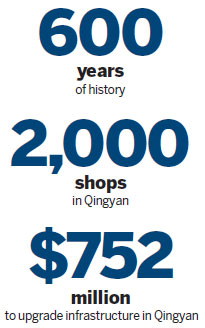New era for ancient town
By Zhao Kai| China Daily|Updated: August 15, 2014
Qingyan's former farmers embrace lifestyle change as tourism brings business opportunities, Zhao Kai reports.
Li Jiaping never thought that his hometown would become a tourism hotspot. The 53-year-old lives in the ancient town of Qingyan, which is in the southern part of Guiyang, in Guizhou province.
The town was built in the Ming dynasty (1368-1644) and today architectural characteristics from the era still remain.
The town's history goes back more than 600 years and it was originally built as a fortress made of earth with stone walls and alleys.

After refurbishment and expansion the fortress turned into a regional hub for business and transport in the area.
However, over time the once bustling town lost its way.
According to Li, who spent his entire life living in Qingyan, the majority of residents were farmers or migrant workers until the local government decided to develop the town into a tourist attraction in 2002.
"The project started with ancient buildings and old lanes with old stone styles, " Li said.
The government encouraged locals to run businesses from their homes.
"My wife and I were the first two volunteers to run a tourism business in our town," Li said.
The couple redecorated their home and set up a shop selling snacks and food.
"My shop started with only five staff members but now we have more than 20 members," Li said.
During the peak season Li said he hires more people to make sure customers are taken care of.
The shops in Qingyan have become a unique attraction themselves and running a store is not only a profitable choice for locals, but also a bonus for people outside the town who want to restart their career in Guizhou.
For example, Li Jinjian, a businessman from Fujian province with skills in silver crafting, moved to the ancient town after hearing how good the market was five years ago.
Li said the ethnic groups in Guizhou had many talented silver craftsmen, which made the competition intense. He said there were more than 40 shops selling silver craft souvenirs in town.
Li said a local silver-smith taught him to create Guizhou and Fujian style pieces, which gives him a little advantage.

Statistics show there are more than 2,000 shops in Qingyan, including inns, restaurants, bars and souvenir stores.
To accelerate the development of the tourism industry the government of Guiyang is determined to invest further in the area.
In 2014, 4.95 billion yuan ($752 million) was spent to upgrade infrastructure including modern parking lots, hotels and service facilities.
When complete, the upgrade will expand Qingyan from 0.8 square kilometers to 4.8 square kilometers.
It is hoped that villages near Qingyan will work together to form a "tourism circle" for visitors to explore.
Senior officials from Guiyang government said they would make sure no damage was done to the local environment and residents during and after the expansion.
"We rejected every real estate related project in order to protect the environment," said Wang Yuxiang, vice-mayor of the municipal government.
Shop owners said although the expansion would lead to more competition they still felt positive about their future.
Li Jiaping said he was happy to see Qingyan growing. "We are happy to see the expansion for our town, because it means Qingyan will become an even better tourism spot, which will definitely attract more tourists," he said. "There are a lot people near Qingyan that still live in poor conditions. The expansion will bring them a chance to change their life just like we did 10 years ago."
Contact the writer at zhangyu1@chinadaily.com.cn
|
With a history of 600 years, Qingyan in Guiyang is an ideal place for tourism. Photos Provided to China Daily |
|
Nanjiang Gorge in Kaiyang county in Guiyang attracts visitors from home and abroad. |






